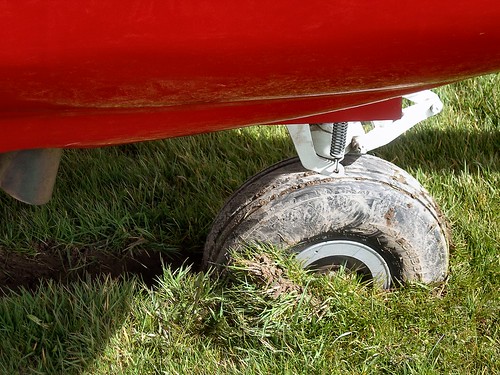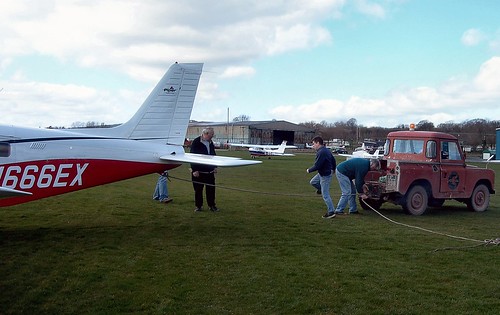Stick in the Mud
When I went to start my day at the desk, there was a whirr and a slight smell of burning and then nothing. The computer stayed dark. I did a walk-around but there’s nothing wrong that I can see: the machine needs an engineer. Meanwhile, I’m using my iPhone to keep the withdrawal symptoms at bay.
While I wait on maintenance, I’ve brought you an article that I wrote for Piper Flyer magazine a few years back. I should note that I’ve not been back to Shobdon since….
Shobdon Airfield started as Pembridge Landing Ground, a long strip in an isolated area used to support Army manoeuvres. In 1942 it was upgraded to “a proper airfield” by the military.
Shaun McGuire has made a website dedicated to the Hereford Parachute Club at Shobdon and has reprinted an article found in Action Stations 3, The Airfields which tells the history of the airfield:
The first visitor after the new airfield opened on May 28, 1942 was a Grumman Martlet which forced-landed whilst on a flight from Yeovilton to Donibristle on June 20. A few days later two Canadian Spitfires landed after getting lost on a cross-country flight. On July 14 the first aircraft to be based – a Lysander – was delivered by an ATA pilot, followed by two dismantled Hotspur gliders brought by road.
I was flying to Shobdon on a whim. Its location on the border of England and Wales meant I was likely to get some lovely views and the attached café had a good reputation. At the time, I didn’t think to look at the history of the airfield, or else I might have seen this:
Shobdon’s grass surfaces on which the gliders usually landed were muddy and unserviceable and half the runway width was unusable because of re-surfacing work.
I was blissfully unaware that the airfield had a reputation for mud when I planned a day trip to Shobdon and back, I was just pleased I could conveniently get my three take-offs and landings in a single afternoon.
Shobdon has a hard runway, over 2,700 feet of asphalt, so I wasn’t particularly interested in the state of their grass. I felt much more prepared than I usually was, as I’d met someone at my local flying club who knew the airfield well.
“Keep a good look out,” he told me. “You get the fighter jets over-flying the place without bothering to talk to anyone. Check the noise abatement procedure, it’s a wide circuit there. And always, always watch the other planes: they have two overhead join procedures: one for locals and one for people who know what an overhead join is.”
He also told me that air-to-ground was “intermittent” so I wasn’t concerned at the radio silence when I approached the airfield later that afternoon. It was quiet, no other planes in the air and no sign of military activity. I landed without any excitement and head over to the clubhouse to get some lunch.
It seemed a nice enough place – the café was tidy and the people were friendly. I got lost looking for the restrooms and ended up in room at the back which seemed the epitome of a Victorian gentlemen’s lounge: wood panelled walls, dark green furniture, varnished tables with crystal ashtrays large enough to hold a cigar or two. I felt quite guilty being in there, an intruder in a masculine world that I’d only ever read about. I backed out nervously before anyone caught me touching the velvet curtains.
A friendly woman in a small wooden cubicle accepted my landing fee and commented what a lovely day it had been and how lucky I was. The week before had been miserable, she told me, non-stop rain. I chatted to her for a bit and then made my way back to the plane.
It was lunchtime and the café had just begun to fill. I’d seen a table full of old airmen, no doubt telling tall tales of the type I love to hear – but I needed to get back home. I settled for a quick cup of coffee at the table next to them. One day I will learn to appreciate tea – after all these years in the UK, you’d think I’d have acquired a taste for it.
I rushed back onto the apron and started up the plane. There was still no one on the radio so I did my calls blind. I was meandering along the taxi-way when I belatedly noticed the sign: “No power checks beyond this point!” I looked around. No other planes were moving. I turned the plane hard to the right so that it was somewhat vaguely into wind and started my checks on the spot.
When I went to turn back onto the taxiway I realised I hadn’t left myself any room to make the turn, I was going to have to enter the grass runway which ran alongside the taxiway. But in that case, I thought, why not just cross the grass and head directly to the asphalt. The radio was silent, no one was coming in, it wasn’t like I was going to be causing any inconvenience.
I made the call and pulled onto the grass. The plane bumped forward and then slowed to a crawl over the uneven ground, losing momentum. I pushed in the throttle but it seemed I was too slow, the plane stopped moving. I increased the power again and then once more. It took a moment before it sank in: I was at full throttle and the plane wasn’t moving. I bit my lip, shut down the engine and clambered out of the plane.
There was no denying it, I was stuck. There was a 3-foot long furrow in the mud. I closed my eyes, I could almost hear the swearing of the future gliders landing on that runway.
At the end of the rut was my nose wheel, covered in mud and dug into the grass. The propeller had bright green streaks all around the edges. If I’d managed to go any deeper, I would have probably taken out the prop but luckily, no damage was done. Except that I needed to get the plane off of the grass somehow.
Help appeared rather rapidly, a plane shutting down perpendicular to the taxiway and runways has that effect. A friendly, sturdy looking guy came out from wherever he had been working to see what had happened.
“The grass runway isn’t usable after the weather we’ve had,” one said, looking at the plane. “It’s a bit muddy out there.” Yeah, I’d noticed. I showed him the nose wheel and he grimaced. Others arrived and a moment later there were four of them in a circle around the Saratoga, shaking their heads at the mess I’d gotten myself into. I stayed on the periphery, they looked like they’d spent their life around planes and were probably taking them to pieces while I was still hoping I’d grow tall enough to be a stewardess. I didn’t think they’d appreciate my input and I didn’t have a chance of getting the plane out without them.
“She’s stuck, all right.”
“If she used full power, couldn’t she…”
“No way, look how close her prop is to the ground already.”
I couldn’t help nodding furiously in agreement every time someone vetoed the “full power and press on” theory.
“Can we push her?” They circled around the plane. I was pretty sure that the female pronoun referred to the plane, not me. I checked to make sure no one was shoving a part of the plane that shouldn’t be shoved, then positioned myself at the nose to heave on the count of three.
The Saratoga rocked backwards and then hit the side of the ridge and lurched forwards again, comfortable in its rut. We could push it out, if we could follow the muddy crevasse I’d created exactly. As it was, we weren’t creating the momentum to push the nose wheel out and over the rut. Even with six of us, it was not enough.
One of the men looked as if he might mention the full power theory again but my new friend who had taken charge spoke first. “We’re going to have to tow her out.”
I didn’t have a clue what this would entail and how this would work. In the end, I simply admitted my helplessness. “I guess I’m not much help.” I got a tolerant smile as a response. I took a chance. “Would it be OK if I took a few photographs of you pulling the plane out?
Luckily they were a friendly bunch; they grinned at me, happy to be captured on film as they rescued this damsel in distress. A battered Landrover was quickly sourced to tug the plane out backwards. They affixed the rope to what we all thought was a tow point on the back of the plane. I later discovered the handy loop was actually for tying the plane down – to my dismay I discovered that the handbook specifically warns against using it to tow. It’s probably a good thing that I didn’t know this while the men positioned themselves: one at the nose of the plane, one at each wing, one in the Landrover and one to stand with the rope. On the count of three, the men shoved, the driver revved carefully and the Saratoga shuddered gently before majestically lifting up and over the rut and then rolling smoothly back to the taxiway. The Landrover towed her back to the sign: “No power checks beyond this point!”
From there it was easy. I thanked them all profusely and did a quick walk-around. Everything looked fine, even the tie-down point. I got into my plane and flew back home, impressed at how friendly everyone had been. I made a mental note to come back to Shobdon … in the summer, after it’s had a chance to dry out.









